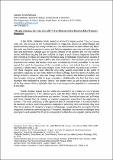Files in this item
“Margot is human, isn’t she, after all?” : the modern girl in interwar élite women’s magazines
Item metadata
| dc.contributor.author | McWilliams, Caroline Mariah | |
| dc.date.accessioned | 2023-01-04T12:30:07Z | |
| dc.date.available | 2023-01-04T12:30:07Z | |
| dc.date.issued | 2022-09-17 | |
| dc.identifier | 281458854 | |
| dc.identifier | cee72f32-507d-45c6-a869-6e09ca7e1f4d | |
| dc.identifier.citation | McWilliams , C M 2022 , ' “Margot is human, isn’t she, after all?” : the modern girl in interwar élite women’s magazines ' , Paper presented at Rewriting Gender in an Age of Transition 1880-1940 , St Andrews , United Kingdom , 16/09/22 - 18/09/22 . | en |
| dc.identifier.citation | conference | en |
| dc.identifier.uri | https://hdl.handle.net/10023/26664 | |
| dc.description.abstract | In the 1930s, Katharine Brush penned an article for Vogue entitled ‘They’re Human After All.’ She focused on the fictional heroine in magazines, whom she called Margot, and questioned why Margot was always written as a one-dimensional character without any flaws. Her point was that the women in society and fashion magazines were very real, with allergies, tears and preferences. Margot was not just the epitome of the modern girl, she was entirely human, with Brush arguing that she should be portrayed as such. Society magazines have often been viewed as frivolous and unworthy of serious study by historians of journalism. Studies of fashion and fashion history have suffered the same treatment.2 This has been partly due to the impression that society and fashion news were dominated by female journalists. It has been argued that until the beginning of the twentieth century, and indeed beyond it, ‘women occupied a “ghetto status” and were engaged solely in the so-called ‘marginal areas of news.’3Yet, these marginal areas were often the only entry women could find to the world of journalism, separated as they were, before universal suffrage, from the realms of politics and foreign relations. However, there was a huge demand for society and fashion journalism, and they brought immense profits to press proprietors. Additionally, the fact that there were countless titles dedicated to women, fashion, and society news, as well as gossip columns in all the big national dailies, highlights that they were integral to the population’s consumption of the news. | |
| dc.format.extent | 193916 | |
| dc.language.iso | eng | |
| dc.subject | DA Great Britain | en |
| dc.subject | D History General and Old World | en |
| dc.subject | P Language and Literature | en |
| dc.subject | NIS | en |
| dc.subject.lcc | DA | en |
| dc.subject.lcc | D | en |
| dc.subject.lcc | P | en |
| dc.title | “Margot is human, isn’t she, after all?” : the modern girl in interwar élite women’s magazines | en |
| dc.type | Conference paper | en |
| dc.contributor.institution | University of St Andrews. School of History | en |
| dc.description.status | Non peer reviewed | en |
This item appears in the following Collection(s)
Items in the St Andrews Research Repository are protected by copyright, with all rights reserved, unless otherwise indicated.

